This post may contain affiliate links. Please read our disclosure policy.
How to make grapefruit juice with or without a juicer. It’s slightly sweet, fairly tart, refreshing, and packed with vitamins, minerals, and antioxidants to boost your immune system. Enjoy it alone, added to juice blends, or in cocktails.
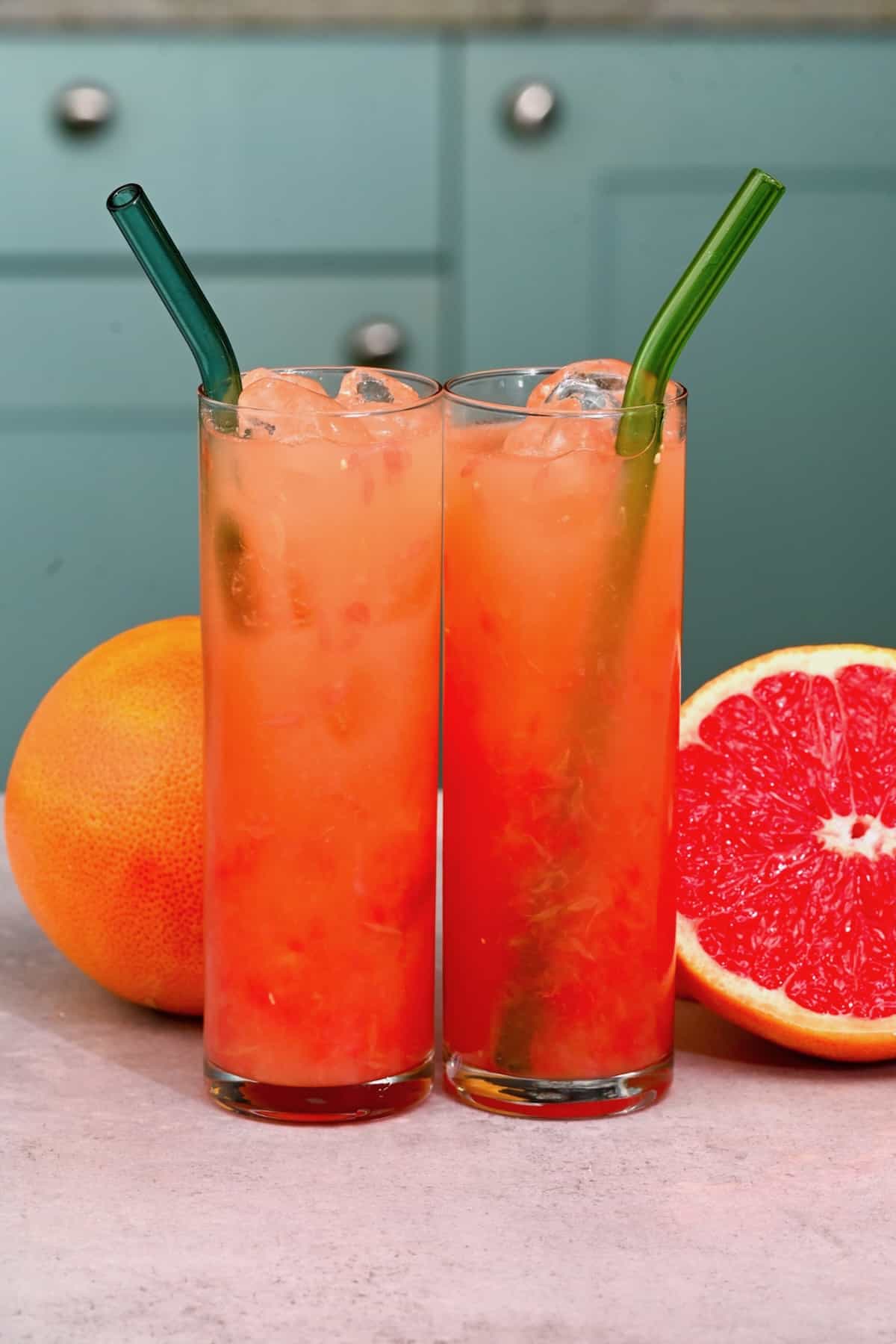
Just like orange juice and apple juice, while it’s easy enough to pick them up in-store, making this tart homemade fresh grapefruit juice is much better! Learn how to make grapefruit juice using a manual citrus press, blender, or juicer, then enjoy it fresh for maximum nutrients.
Plus, you can control exactly what goes in the juice, including customizing the sweetness, consistency (pulpy vs. smooth), and flavor (with added fruits, etc.), with no preservatives!
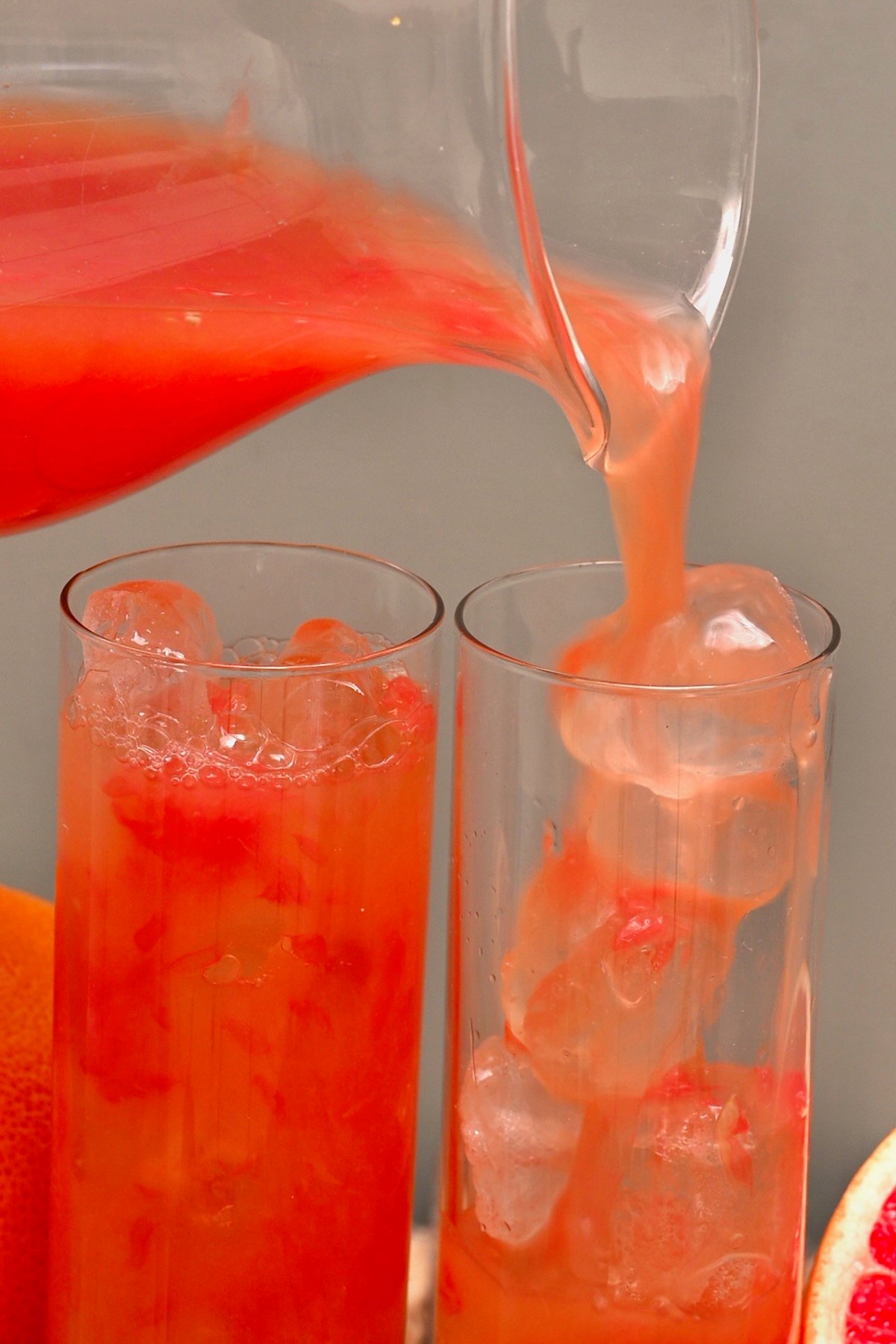
Want to save this recipe?
How Many Types of Grapefruit Are There
Grapefruits come in various colors, including yellow, pink, and red, with a sweet, sharp, tangy flavor. The sourness differs between types. In terms of exactly how many types there are, it’s hard to say, though there are over 20 varieties of grapefruit grown in the US alone.
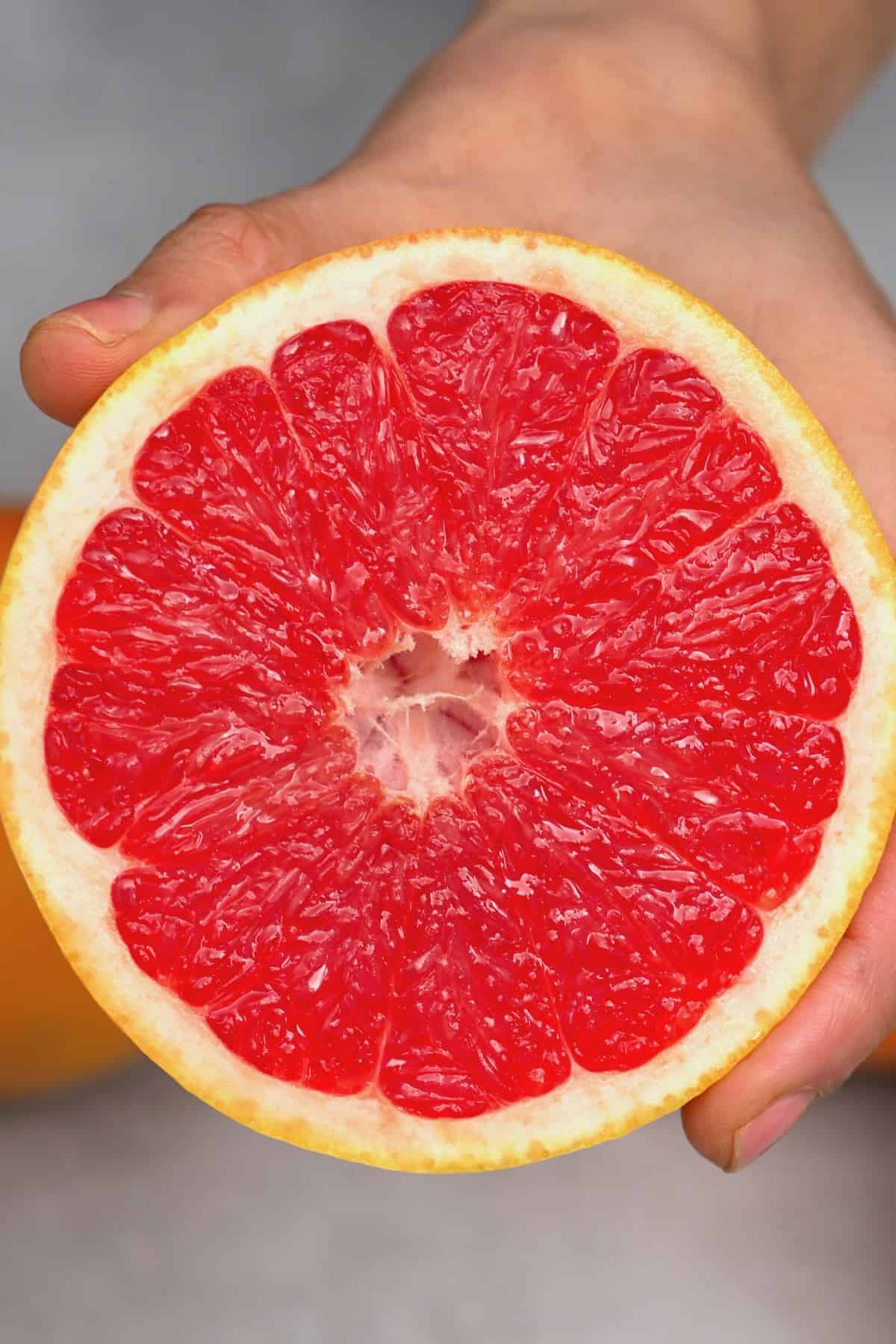
What Is The Best Tasting Grapefruit?
The best grapefruit juice comes down to personal taste. However, in terms of flavor:
- Oro Blanco grapefruit: “White Gold” – these are a cross between a pomelo and white grapefruit with bright green peel and sweet flesh with the least bitterness of all.
- Melogold: Another pomelo-grapefruit hybrid. It has lime-green skin and is super juicy, flavorful, and sweet.
- White grapefruit: Has pale yellow skin and the least sweetness, with the sourest (rather than bitter) flavor, but super aromatic.
- Pink grapefruit: A sweet and tart, slightly sour flavor packed with depth, often used for juicing.
- Star ruby: Ruby red flesh with yellow-red peel (the darker it is, the sweeter the flavor) and a wonderful combination of sweet and sour flavor.
- Red grapefruit: While this contains extra antioxidants and has a pretty bitter taste.
In my opinion, the best grapefruit for juicing is pink grapefruit, as it’s delicious and easily found in grocery stores.
How to Make Grapefruit Juice
How to juice grapefruit in one of three ways for a quick, simple, and super refreshing treat.
With a Juicer
Juicing grapefruit with a juicer is the fastest and most convenient option, requiring minimal prep or effort.
- First, peel the grapefruit.
- Then chop it into smaller parts to fit your juicer chute.
- Feed them through your juicer – and voila.
With a Blender
Making grapefruit juice in a blender means diluting it with water, but it’s quick and simple.
- First, peel the fruit and roughly chop it into several pieces. If there are any seeds, remove them with a fork.
- Along with the fruit, add 1/4-1/2 cup of water (per fruit) to the machine.
For more flavor, use coconut water or any other type of juice (orange, apple, pineapple).
- Then, blend it into a juicy, pulpy consistency. This will take between 45-60 seconds.
- For smooth juice, pour it into your glass through a strainer or a nut milk bag/muslin cloth. If doing the latter, squeeze gently, or you’ll make a mess.
With a Hand Held Juicer or a Citrus Juicer
With almost every household hiding a citrus juicer somewhere, this is great for those who don’t own appliances like a blender or juicer. While it takes longer and more effort, the process is still quick and simple.
- Start by slicing the grapefruit/s in half.
To extract the most juice, I recommend rolling it against the counter for 20-30 seconds to loosen the pulp (and/or microwave it for 15-20 seconds).
- Some hand juicers just need pressing, and others require you to squeeze and rotate the fruit over the juicing element manually. Make sure to place a bowl underneath.
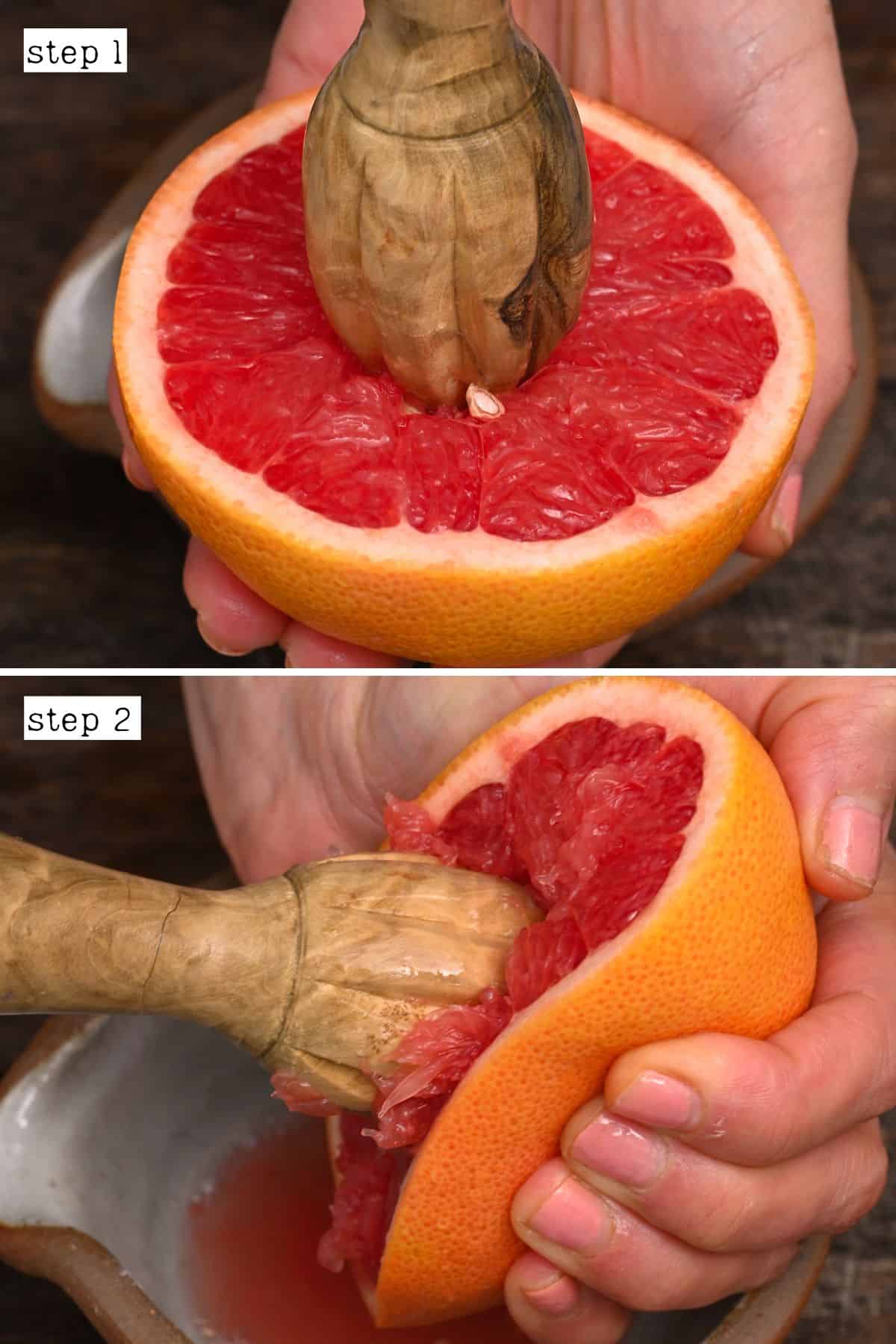
If you’d prefer pulp (for fiber) in the juice, you can scoop it directly from the leftover fruit into the juice.
How to Make Grapefruit Juice Less Bitter
Many enjoy grapefruit with a sprinkle of sugar/Splenda to cut the bitterness in this citrus fruit. You can do something similar with grapefruit juice, adding some honey, maple syrup, agave, sugar/sugar alternative, or even flavored syrups.
Alternatively, avoid added sugars by pairing the juice with other fruit juices:
It also pairs particularly well with berries (like strawberry juice), mango, kiwi juice, and ginger (1 inch of fresh ginger). Brighten it further with a squeeze of fresh lemon juice or lime juice.
You can also dilute it with water or sparkling water. I love to serve mine over ice.
You can also use this fresh grapefruit juice to add to cocktails, enjoy with spirits (like vodka or gin), mix into salad dressings, make into syrup, turn into sorbet, or even mix with yogurt and freeze into popsicle molds.
Grapefruit Orange Juice
One of my favorite juice blends combines a 2:1 ratio of grapefruit and orange juice. However, play around with the ratio to your liking.
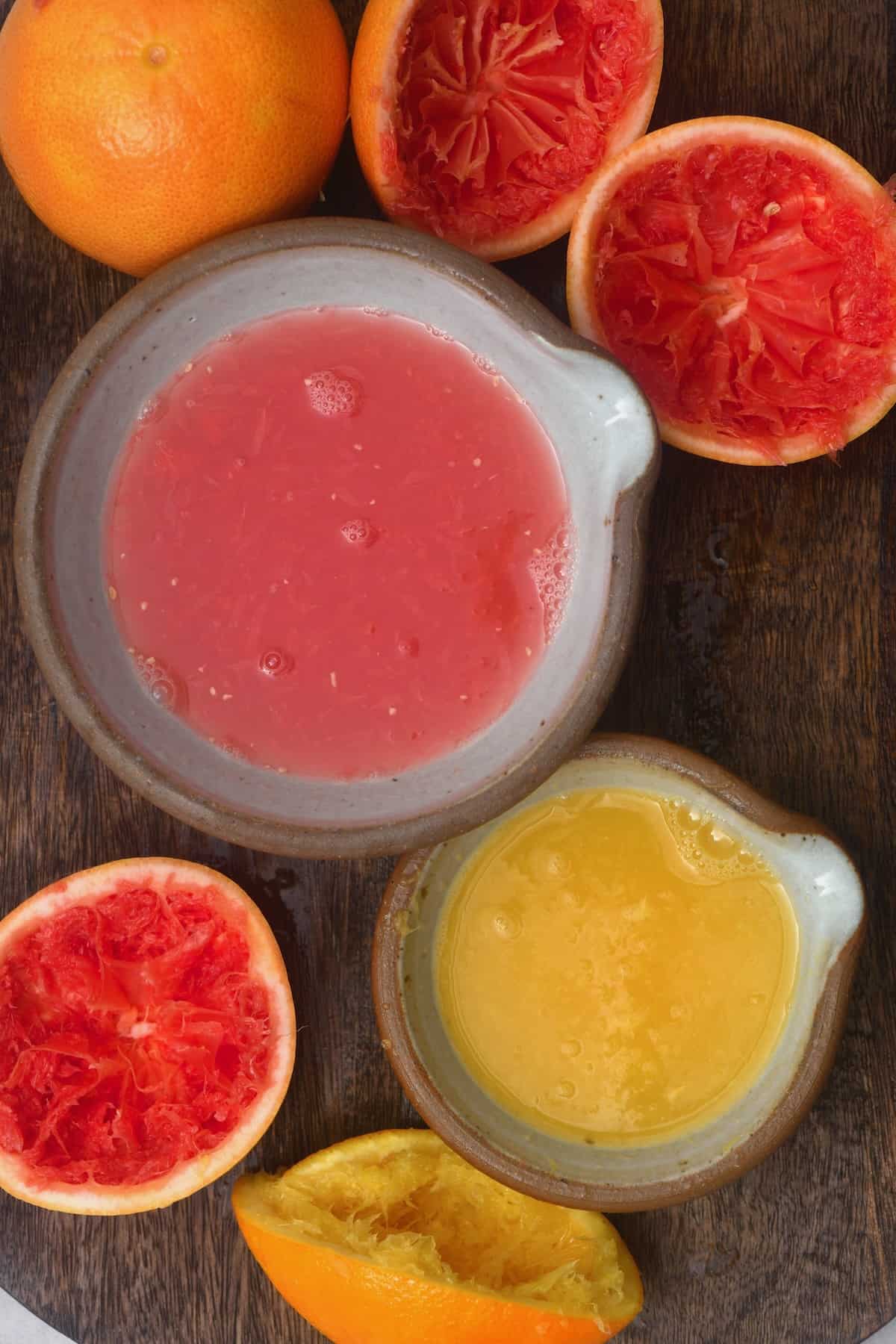
FAQs
Pomelo is closely related to grapefruit but much larger (like a small melon) and teardrop shaped with a green peel and much thicker rind. It tastes similar but sweeter, with a firm, almost crisp texture.
You can freeze the juice in Ziplock bags or ice cube trays (then transfer to freezer bags) for up to 6 months.
Add the ice cubes directly to sparkling water and other drinks, or thaw it first to enjoy.
Enjoy it immediately for the most nutrients. Any leftovers will last for 2-3 days in the fridge. Give it a good shake or stir before serving each time.
It depends on the variety. In general, one pink grapefruit yields about 2/3-1 cup of juice (about 160 ml).
You can store the fruit in your fridge for up to 3 weeks, though they’ll taste best when at room temperature. In that case, it’s best to consume them within a week.
Grapefruits are loaded with vitamin C, making them a great protector and immune-system booster during cold and flu season.
There are several ways you can enjoy the leftover grapefruit peel.
1. If both halves of the peel are in good shape, make homemade grapefruit candles.
2. Make candied grapefruit peel.
3. Add to body scrubs or face scrubs.
4. Zest the grapefruit and store it in the freezer to use in recipes.
5. Make an all-natural, all-purpose citrus cleaning spray.
You can either use it immediately or freeze it in an ice-cube tray for later. I use leftover juice pulp in smoothies, broths, and baked goods. If you don’t want to ingest it, it’s also compostable.
More Juice Recipes
Or browse through this collection of 30 juicing recipes!
If you try this simple homemade grapefruit juice recipe, let me know how it goes in the comments below. I’d appreciate a recipe card rating and would love to see your recipe recreations – tag me on Instagram @Alphafoodie!

How to Make Grapefruit Juice (3 Methods)
Ingredients
- 25 oz grapefruits 2 medium; use pink grapefruits or Star Ruby grapefruits if possible
- 12 oz orange 1 medium; optional for grapefruit orange juice.
This will yield about 1 ¾ cups/420 ml of juice
Instructions
With a Juicer
- Peel the fruit.
- Chop it into smaller parts to fit your juicer chute.
- Feed the grapefruit pieces through your juicer – and voila!
With a Blender
- Peel the fruit and roughly chop it into several pieces. If there are any seeds, remove them with a fork.
- Along with the fruit, add 1/4-1/2 cup of water (per fruit) to the machine.For more flavor, use coconut water or any other type of juice (orange, apple, pineapple).
- Blend into a juicy, pulpy consistency. This will take between 45-60 seconds.For smooth juice, pour it into your glass through a strainer or a nut milk bag/muslin cloth. If doing the latter, squeeze gently, or you’ll make a mess.
With a Hand Held Juicer or a Citrus Juicer
- Start by slicing the grapefruit/s in half.To extract the most juice, I recommend rolling it against the counter for 20-30 seconds to loosen the juice (and/or microwave it for 15-20 seconds).
- Some hand juicers just need pressing, and others require you to manually squeeze and rotate the fruit over the juicing element. Make sure to place a bowl underneath.If you’d prefer pulp (for fiber) in the juice, you can scoop it directly from the leftover fruit into the juice.
Video
Notes
- To avoid bitterness: Remove the white pith and any seeds. I often don’t do this if drinking the juice immediately, though.
- Sweeten to taste: I like to combine juices to add natural sweetness but feel free to add some honey, syrup, or sugar to taste.
- Adjust the consistency: You can strain the juice, leave it pulpy, or even add some pulp back into the juicer juice.
Nutrition
Nutrition information is automatically calculated, so should only be used as an approximation.















Sounds delicious
Hey David! I’m glad you think it sounds delicious! Making grapefruit juice is super easy and refreshing. Just grab some fresh grapefruits, cut them in half, and squeeze out the juice. You can even add a little sugar or honey if you want it sweeter. Enjoy!